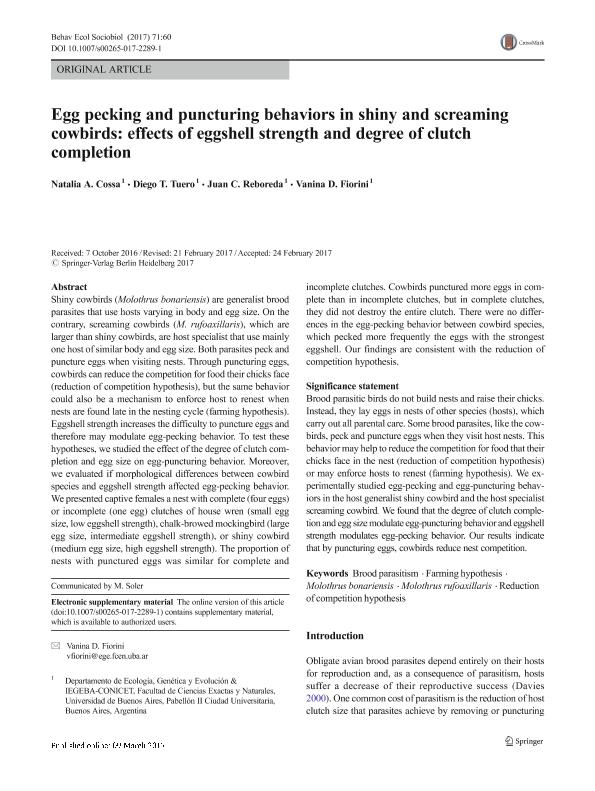Mostrar el registro sencillo del ítem
dc.contributor.author
Cossa, Natalia Andrea

dc.contributor.author
Tuero, Diego Tomas

dc.contributor.author
Reboreda, Juan Carlos

dc.contributor.author
Fiorini, Vanina Dafne

dc.date.available
2018-11-27T18:12:41Z
dc.date.issued
2017-04
dc.identifier.citation
Cossa, Natalia Andrea; Tuero, Diego Tomas; Reboreda, Juan Carlos; Fiorini, Vanina Dafne; Egg pecking and puncturing behaviors in shiny and screaming cowbirds: effects of eggshell strength and degree of clutch completion; Springer; Behavioral Ecology And Sociobiology; 71; 4; 4-2017; 60
dc.identifier.issn
0340-5443
dc.identifier.uri
http://hdl.handle.net/11336/65351
dc.description.abstract
Abstract: Shiny cowbirds (Molothrus bonariensis) are generalist brood parasites that use hosts varying in body and egg size. On the contrary, screaming cowbirds (M. rufoaxillaris), which are larger than shiny cowbirds, are host specialist that use mainly one host of similar body and egg size. Both parasites peck and puncture eggs when visiting nests. Through puncturing eggs, cowbirds can reduce the competition for food their chicks face (reduction of competition hypothesis), but the same behavior could also be a mechanism to enforce host to renest when nests are found late in the nesting cycle (farming hypothesis). Eggshell strength increases the difficulty to puncture eggs and therefore may modulate egg-pecking behavior. To test these hypotheses, we studied the effect of the degree of clutch completion and egg size on egg-puncturing behavior. Moreover, we evaluated if morphological differences between cowbird species and eggshell strength affected egg-pecking behavior. We presented captive females a nest with complete (four eggs) or incomplete (one egg) clutches of house wren (small egg size, low eggshell strength), chalk-browed mockingbird (large egg size, intermediate eggshell strength), or shiny cowbird (medium egg size, high eggshell strength). The proportion of nests with punctured eggs was similar for complete and incomplete clutches. Cowbirds punctured more eggs in complete than in incomplete clutches, but in complete clutches, they did not destroy the entire clutch. There were no differences in the egg-pecking behavior between cowbird species, which pecked more frequently the eggs with the strongest eggshell. Our findings are consistent with the reduction of competition hypothesis. Significance statement: Brood parasitic birds do not build nests and raise their chicks. Instead, they lay eggs in nests of other species (hosts), which carry out all parental care. Some brood parasites, like the cowbirds, peck and puncture eggs when they visit host nests. This behavior may help to reduce the competition for food that their chicks face in the nest (reduction of competition hypothesis) or may enforce hosts to renest (farming hypothesis). We experimentally studied egg-pecking and egg-puncturing behaviors in the host generalist shiny cowbird and the host specialist screaming cowbird. We found that the degree of clutch completion and egg size modulate egg-puncturing behavior and eggshell strength modulates egg-pecking behavior. Our results indicate that by puncturing eggs, cowbirds reduce nest competition.
dc.format
application/pdf
dc.language.iso
eng
dc.publisher
Springer

dc.rights
info:eu-repo/semantics/openAccess
dc.rights.uri
https://creativecommons.org/licenses/by-nc-sa/2.5/ar/
dc.subject
Brood Parasitism
dc.subject
Farming Hypothesis
dc.subject
Molothrus Bonariensis
dc.subject
Molothrus Rufoaxillaris
dc.subject
Reduction of Competition Hypothesis
dc.subject.classification
Otras Ciencias Biológicas

dc.subject.classification
Ciencias Biológicas

dc.subject.classification
CIENCIAS NATURALES Y EXACTAS

dc.title
Egg pecking and puncturing behaviors in shiny and screaming cowbirds: effects of eggshell strength and degree of clutch completion
dc.type
info:eu-repo/semantics/article
dc.type
info:ar-repo/semantics/artículo
dc.type
info:eu-repo/semantics/publishedVersion
dc.date.updated
2018-10-23T18:32:38Z
dc.journal.volume
71
dc.journal.number
4
dc.journal.pagination
60
dc.journal.pais
Alemania

dc.journal.ciudad
Berlin
dc.description.fil
Fil: Cossa, Natalia Andrea. Consejo Nacional de Investigaciones Científicas y Técnicas. Oficina de Coordinación Administrativa Ciudad Universitaria. Instituto de Ecología, Genética y Evolución de Buenos Aires. Universidad de Buenos Aires. Facultad de Ciencias Exactas y Naturales. Instituto de Ecología, Genética y Evolución de Buenos Aires; Argentina. Universidad de Buenos Aires. Facultad de Ciencias Exactas y Naturales. Departamento de Ecología, Genética y Evolución; Argentina
dc.description.fil
Fil: Tuero, Diego Tomas. Consejo Nacional de Investigaciones Científicas y Técnicas. Oficina de Coordinación Administrativa Ciudad Universitaria. Instituto de Ecología, Genética y Evolución de Buenos Aires. Universidad de Buenos Aires. Facultad de Ciencias Exactas y Naturales. Instituto de Ecología, Genética y Evolución de Buenos Aires; Argentina. Universidad de Buenos Aires. Facultad de Ciencias Exactas y Naturales. Departamento de Ecología, Genética y Evolución; Argentina
dc.description.fil
Fil: Reboreda, Juan Carlos. Consejo Nacional de Investigaciones Científicas y Técnicas. Oficina de Coordinación Administrativa Ciudad Universitaria. Instituto de Ecología, Genética y Evolución de Buenos Aires. Universidad de Buenos Aires. Facultad de Ciencias Exactas y Naturales. Instituto de Ecología, Genética y Evolución de Buenos Aires; Argentina. Universidad de Buenos Aires. Facultad de Ciencias Exactas y Naturales. Departamento de Ecología, Genética y Evolución; Argentina
dc.description.fil
Fil: Fiorini, Vanina Dafne. Consejo Nacional de Investigaciones Científicas y Técnicas. Oficina de Coordinación Administrativa Ciudad Universitaria. Instituto de Ecología, Genética y Evolución de Buenos Aires. Universidad de Buenos Aires. Facultad de Ciencias Exactas y Naturales. Instituto de Ecología, Genética y Evolución de Buenos Aires; Argentina. Universidad de Buenos Aires. Facultad de Ciencias Exactas y Naturales. Departamento de Ecología, Genética y Evolución; Argentina
dc.journal.title
Behavioral Ecology And Sociobiology

dc.relation.alternativeid
info:eu-repo/semantics/altIdentifier/doi/https://dx.doi.org/10.1007/s00265-017-2289-1
dc.relation.alternativeid
info:eu-repo/semantics/altIdentifier/url/https://link.springer.com/article/10.1007/s00265-017-2289-1
Archivos asociados
